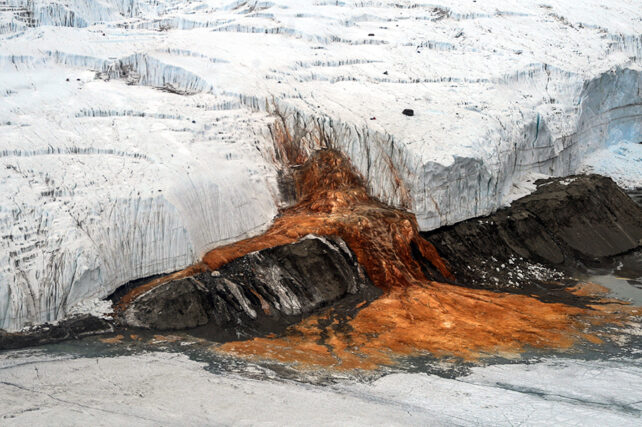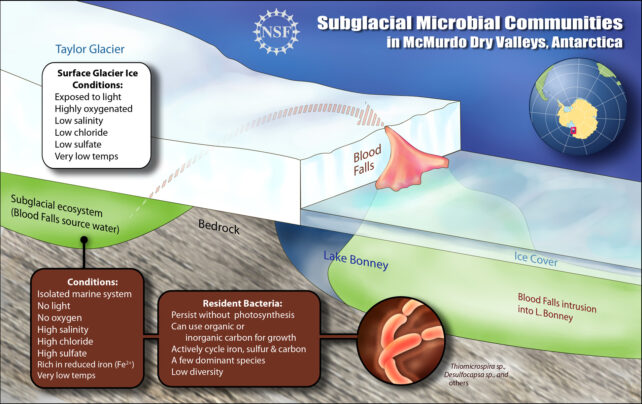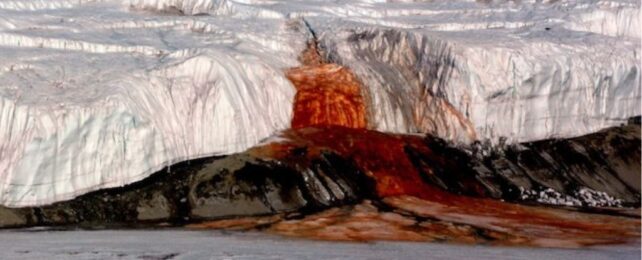In a pale world of ice and snow, the last color you expect to see on the horizon is red.
In 1911, during a British expedition to Antarctica, researchers were shocked to notice a glacier 'bleeding' from its tongue onto an ice-covered lake.
The crimson drool is known as Blood Falls, and it's taken experts more than a century to figure out what is actually causing the eerie coloring.
When a team of US scientists took samples from Taylor Glacier's rusty tongue in November 2006 and mid and late November 2018, and analyzed the contents using powerful electron microscopes, they caught the true culprit 'red-handed'.
While plenty of studies have been conducted on the chemistry and microbes living in the discharge leaking from Antarctica's Blood Falls, a full breakdown of its mineralogical make-up had yet to be undertaken. Using an array of analytical equipment, the researchers uncovered a few surprises that helped better explain the iconic red hue.
"As soon as I looked at the microscope images, I noticed that there were these little nanospheres and they were iron-rich," explains materials scientist Ken Livi from Johns Hopkins University.
The minuscule particles come from ancient microbes and are a hundredth of the size of human red blood cells. They are highly abundant in the meltwaters of Taylor Glacier, which was named after the British scientist Thomas Griffith Taylor who first noticed the Blood Falls on the 1910 to 1913 expedition.
Along with iron, the nanospheres also contain silicon, calcium, aluminum, and sodium, and this unique composition is part of what turns the briny, subglacial water red as it slips off the glacier's tongue and meets a world of oxygen, sunlight, and warmth for the first time in a long time.
"In order to be a mineral, atoms must be arranged in a very specific, crystalline, structure," explains Livi.
"These nanospheres aren't crystalline, so the methods previously used to examine the solids did not detect them."

The Taylor Glacier in Antarctica hosts an ancient microbial community hundreds of meters under its ice, which has evolved in isolation for millennia, or possibly even millions of years.
As such, it's a useful 'playground' for astrobiologists, hoping to discover hidden life forms on other planets, too.
But the new findings suggest that if robots like the Mars Rover don't have the right equipment on board, they might not be able to detect all the lifeforms present beneath a planet's icy bodies.
The spectroscopic equipment used to identify the nanospheres in the current study, for instance, could not be taken to Antarctica. Instead, samples had to be sent to labs overseas.

The findings support a previous hypothesis, which suggests the reason scientists haven't yet detected life on Mars is because current technology can't always spot the signatures of life, even when a rover rolls right over them.
If a Mars rover landed in Antarctica right now, for instance, it wouldn't be able to detect the microbial nanospheres that turn Taylor Glacier's terminus into a fan of red.
"Our work has revealed that the analysis conducted by rover vehicles is incomplete in determining the true nature of environmental materials on planet surfaces," says Livi.
"This is especially true for colder planets like Mars, where the materials formed may be nanosized and non-crystalline. Consequently, our methods for identifying these materials are inadequate."
Unfortunately, attaching an electron microscope to a Mars rover is currently not feasible. These devices are simply too bulky and power hungry, which means that samples will need to be returned from Mars to Earth if we really want to study them for nanoscopic evidence of life.
The study was published in Astronomy and Space Science.
